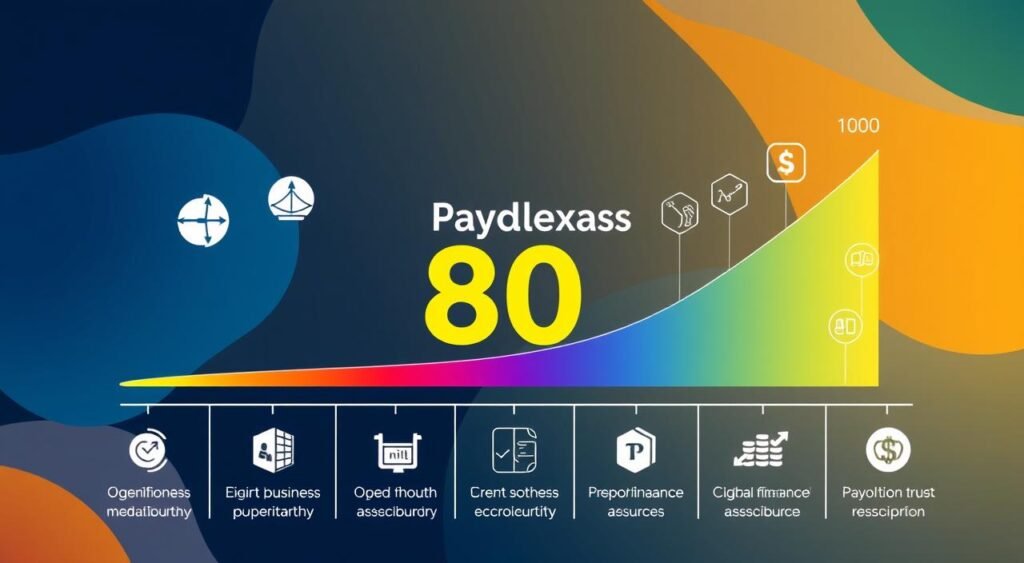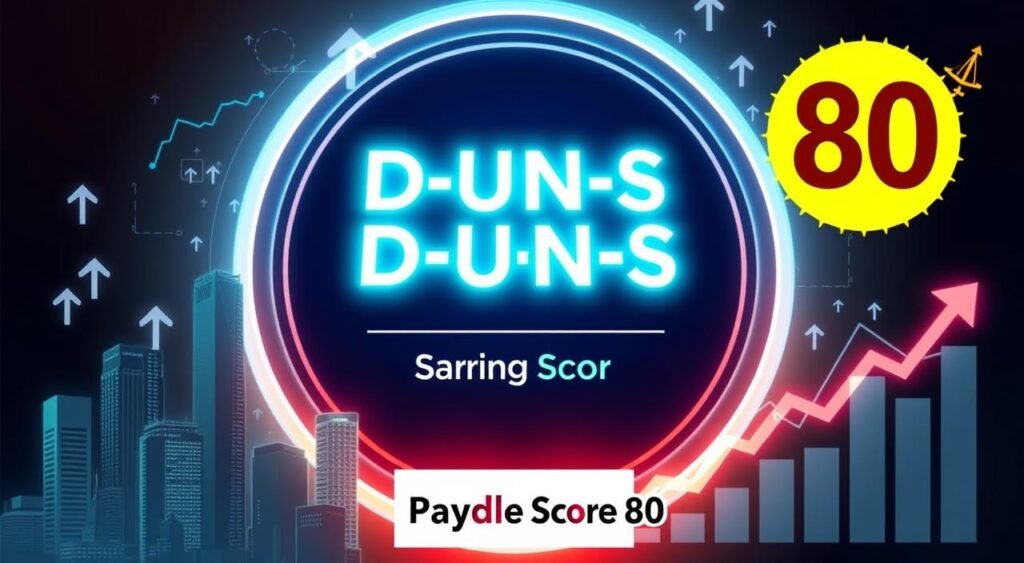Ever wondered how your business’s payment history impacts its financial future? The PAYDEX score, a crucial metric for business credit, can make or break your company’s financial opportunities. This unique dollar-weighted indicator, ranging from 0 to 100, reflects how your firm has paid its bills over the past year.
A PAYDEX score of 90 or above signals excellent payment performance, while anything below 70 raises red flags. For small business owners, understanding and improving this score is key to unlocking financing for growth. Let’s dive into the essential tips and tricks to boost your PAYDEX score and build a solid business credit foundation.
Key Takeaways
- PAYDEX scores range from 0 to 100, with higher scores indicating better payment performance
- Paying bills early can significantly improve your PAYDEX score
- Regular monitoring of your business credit report is crucial
- Maintaining low credit utilization positively impacts your score
- Building strong relationships with vendors can enhance your PAYDEX score
- A D-U-N-S Number is essential for establishing your business credit profile
- Consistent, timely payments are the cornerstone of a good PAYDEX score
Understanding the PAYDEX Score
The PAYDEX Score plays a crucial role in credit score management for businesses. This unique metric offers insights into a company’s financial responsibility and payment habits.
What is a PAYDEX Score?
A PAYDEX Score is a numerical representation of a business’s payment history, ranging from 1 to 100. A score of 100 indicates a perfect payment record, while lower scores suggest potential payment issues2. Good scores start at 75, showing low risk and reliability in timely repayments2.
How PAYDEX Scores are calculated
Dun & Bradstreet calculates PAYDEX scores by analyzing payment data from suppliers and vendors over a 12-month period. The score requires at least three credit experiences from two tradelines. It’s dollar-weighted, meaning each payment’s value impacts the final score2.
| PAYDEX Score | Payment Behavior | Risk Level |
|---|---|---|
| 100 | 30 days early | Lowest |
| 75-99 | On time to early | Low |
| 50-74 | Slightly late | Medium |
| 0-49 | Late | High |
The importance of PAYDEX for businesses
Your PAYDEX score can significantly impact your business operations. Lenders and creditors use this score to make decisions about extending credit or loans2. A good score (75 or higher) can lead to better terms from vendors and suppliers2. Unlike personal credit scores that range from 300 to 850, business credit scores like PAYDEX simplify the separation of personal and business finances3.
Improving your PAYDEX score involves prompt payments to vendors and suppliers. Paying early can help you achieve a perfect score, demonstrating strong financial responsibility2. Building business credit through establishing tradelines and actively managing payment history contributes to enhancing your PAYDEX score and overall credit profile2.
The PAYDEX Score Range and Its Significance
Understanding your PAYDEX score is crucial for business credit building. This score, ranging from 0 to 100, reflects your company’s payment performance to vendors and suppliers45. A higher score indicates better payment habits, which can significantly impact your business credit profile.
PAYDEX scores are categorized into three risk levels:
- 80-100: Low risk (payments up to 30 days early)
- 50-79: Medium risk (payments 2-30 days late)
- 0-49: High risk (payments 31-120 days late)45
Aiming for a score of 80 or above is ideal, as it suggests you pay bills on time or early. This can enhance your creditworthiness and open doors to better financing options5.

It’s important to note that PAYDEX scores are dollar-weighted. This means larger payments have a more significant impact on your score45. For instance, being late on a substantial payment will affect your score more than a delay in a smaller payment.
To establish a PAYDEX score, your business needs:
- A D-U-N-S number (typically takes up to 30 days to obtain)
- At least three reported trade experiences from two or more trade references45
Remember, personal credit history doesn’t influence your PAYDEX score. It’s solely based on commercial transaction data from the past two years45. By consistently making timely payments and monitoring your score, you can implement effective credit score improvement tips to boost your business credit profile.
“A strong PAYDEX score is a testament to your business’s financial responsibility and can be a powerful tool in securing favorable terms with suppliers and lenders.”
Credit Score Improvement Tips for Your PAYDEX
Boosting your PAYDEX score is crucial for business success. This score, ranging from 1 to 100, indicates your payment risk level6. Let’s explore effective strategies to enhance your business credit standing.
Pay bills early or on time
Timely payment habits are the cornerstone of payment history optimization. Aim to pay your bills before they’re due. This practice not only avoids late fees but also positively impacts your PAYDEX score. Remember, simply paying on time may not be enough; early payments can give your score an extra boost.
Maintain active credit lines
Keep your credit lines active and in good standing. Regular use of business credit cards and timely repayments demonstrate responsible credit management. This activity contributes to a healthy credit utilization ratio, a key factor in your overall business credit profile.
Monitor and address errors in your credit history
Regularly review your business credit reports from major bureaus like Dun & Bradstreet, Experian, and Equifax7. Look for any inaccuracies or falsely reported past-due accounts. Promptly dispute any errors you find to ensure your credit history accurately reflects your payment performance.
| Action | Impact on PAYDEX |
|---|---|
| Pay bills early | Significant boost |
| Pay bills on time | Moderate improvement |
| Maintain active credit lines | Steady growth |
| Address credit report errors | Prevent unwarranted drops |
By implementing these strategies, you’re on the path to a stronger PAYDEX score. Remember, consistency in your payment history optimization efforts is key to long-term success in managing your business credit.
Establishing and Managing Trade Lines
Trade lines are crucial for building your PAYDEX Score and advancing your business credit building efforts. These lines represent your credit accounts with suppliers and vendors who report payment experiences to Dun & Bradstreet (D&B). Establishing strong trade lines is a key step in vendor relationship maintenance.

To start, reach out to your current suppliers and ask if they report to D&B. If not, consider finding vendors who do. This proactive approach can significantly boost your PAYDEX Score. Remember, positive tradelines, marked by on-time payments and low credit utilization, demonstrate responsible credit management8.
D&B offers CreditBuilder packages to help you manage your trade lines effectively. These tools allow you to submit payment information directly to D&B, giving you more control over your business credit profile. The CreditBuilder Plus package lets you submit up to 12 payments per year, while the Premium package offers unlimited submissions.
“Building strong trade lines is like laying a solid foundation for your business credit. It takes time and effort, but the payoff is substantial.”
Consider these strategies for managing your trade lines:
- Pay bills early or on time consistently
- Keep credit utilization low
- Maintain a mix of different credit accounts
- Regularly monitor your business credit reports
By focusing on these aspects, you can build a strong business credit profile. Positive business tradelines contribute significantly to your overall creditworthiness, potentially leading to better financing options and increased credibility with suppliers and lenders8.
| Trade Line Management Strategy | Benefit |
|---|---|
| Early payments | Higher PAYDEX Score |
| Low credit utilization | Improved creditworthiness |
| Diverse credit mix | Stronger overall credit profile |
| Regular monitoring | Quick error detection and correction |
Remember, building credit takes time. If you’re just starting, don’t worry about having a thin credit file. Focus on establishing and maintaining positive trade lines. As you grow, consider adding authorized users or exploring rent reporting services to further strengthen your credit profile9.
The Role of D-U-N-S Number in PAYDEX Scoring
The D-U-N-S Number plays a crucial role in business credit building and financial responsibility. This unique nine-digit identifier, assigned by Dun & Bradstreet, is essential for establishing your PAYDEX Score10. It acts as a business fingerprint, allowing creditors, vendors, and suppliers to evaluate your company’s creditworthiness10.

How to apply for a D-U-N-S Number
Applying for a D-U-N-S Number is a straightforward process:
- Visit the Dun & Bradstreet website
- Fill out the application form with your business details
- Submit the application
- Wait for processing (up to 30 days for standard applications)11
The standard application is free, but expedited processing is available for $229 if you need it urgently11. This investment can be worthwhile for businesses seeking rapid credit building opportunities.
Why a D-U-N-S Number is crucial for your business credit
A D-U-N-S Number is vital for your business credit profile. It enables Dun & Bradstreet to calculate your PAYDEX Score based on reported payments from suppliers12. With a positive PAYDEX score, you can:
- Qualify for credit in your business name12
- Access better payment terms and financing options11
- Obtain business credit limits exceeding $100,00012
Remember, it only takes 60 days to establish a positive PAYDEX credit score12. By maintaining timely payments and aiming for a score of 80 or higher, you demonstrate strong financial responsibility and enhance your business’s credibility.
| PAYDEX Score Range | Interpretation |
|---|---|
| 80-100 | Very Good |
| 70-79 | Good |
| 50-69 | Fair |
| 0-49 | Poor |
Obtaining a D-U-N-S Number is a smart step in your business credit building journey. It opens doors to better financial opportunities and helps establish a solid foundation for your company’s growth.
Monitoring Your PAYDEX Score
Keeping tabs on your PAYDEX score is crucial for effective credit score management. This score, ranging from 0 to 100, reflects your business’s payment performance, with higher scores indicating better creditworthiness1. Regular credit monitoring helps you track improvements and identify areas for enhancement in your business credit profile.
To start monitoring your PAYDEX score, you can access it for free through D&B’s CreditSignal program for 14 days1. After this period, you’ll receive updates only when your score changes. For more comprehensive monitoring, consider subscribing to D&B’s monthly credit-building packages.
D&B offers two main packages for enhanced credit monitoring:
- CreditBuilder Plus: $149 per month, allowing up to 12 payment submissions yearly
- CreditBuilder Premium: $199 per month, offering unlimited payment submissions1
These packages provide valuable insights into your business credit health and help you maintain a strong PAYDEX score. Remember, timely payments are crucial – even a payment one day late can lower your score13.
By actively monitoring and managing your PAYDEX score, you can lower your cost of doing business, improve cash flow, and open new opportunities for your company13. Stay proactive in your credit score management to ensure your business maintains a strong financial foundation14.
Strategies for Improving Credit Utilization
Your credit utilization ratio plays a crucial role in determining your overall creditworthiness. This key metric can significantly impact your credit score, making it essential to understand and manage effectively.
Understanding Credit Utilization Ratio
Credit utilization ratio refers to the amount of credit you’re using compared to your total available credit. This factor accounts for about 30% of your FICO score and 20% of your VantageScore, underlining its importance in credit scoring models1516. Experts recommend keeping your utilization below 30% to maintain a good credit score15.
Tips for Maintaining a Healthy Credit Utilization
To improve your credit utilization and boost your credit score, consider these credit score improvement tips:
- Keep balances low: Aim to use less than 30% of your available credit across all accounts16.
- Pay off balances regularly: Frequent payments can help keep your utilization low, even if you use your cards often.
- Request credit limit increases: A higher credit limit can lower your utilization ratio15.
- Spread purchases across multiple cards: This can help maintain lower utilization rates on individual cards16.
- Keep old accounts open: Closing unused credit cards can negatively impact your credit score by reducing your total available credit15.
By implementing these strategies, you can effectively manage your credit utilization ratio. This, in turn, can lead to a higher credit score, potentially resulting in benefits like lower interest rates on loans and access to better credit card rewards programs15. Remember, using credit cards wisely while maintaining low utilization can positively impact your financial life15.
Building Strong Vendor Relationships for Better PAYDEX Scores
Strong vendor relationships are key to improving your PAYDEX score. Vendor relationship maintenance plays a crucial role in business credit building. By fostering good connections with suppliers, you can encourage them to report positive payment experiences to Dun & Bradstreet.
To boost your PAYDEX score, focus on timely payments. Paying bills early or on time can significantly impact your score. A score of 80 indicates early payments made within the first 30 days after the due date, while a perfect 100 signifies impeccable financial responsibility with consistent on-time payments17.
Consider these strategies for effective vendor relationship maintenance:
- Communicate openly with vendors about payment terms
- Set up automatic payments to ensure timeliness
- Explore vendor financing options for better payment flexibility
- Regularly review and update vendor information
Remember, Dun & Bradstreet requires at least two tradelines with three credit experiences each for a PAYDEX score to be generated18. By maintaining strong relationships with multiple vendors, you increase your chances of building a robust business credit profile.
Effective business credit building also involves keeping personal and business finances separate. Apply for a corporate card to establish credit history and set spending limits19. This practice not only aids in building credit but also simplifies financial management.
By prioritizing vendor relationship maintenance and implementing these strategies, you’ll be well on your way to improving your PAYDEX score and strengthening your overall business credit profile.
Conclusion
Boosting your PAYDEX score is crucial for business credit building and financial responsibility. By implementing credit score improvement tips, you can enhance your company’s creditworthiness and secure better financing terms. Remember, payment history accounts for 35% of your FICO® Score, emphasizing the importance of timely payments20.
Maintaining a low credit utilization ratio is vital, with an ideal ratio of 10% or less. This factor holds significant weight in FICO score calculations, demonstrating its impact on your overall credit health21. Actively managing your credit mix and limiting new credit applications can further contribute to a stronger PAYDEX score.
By focusing on these key areas, you’re not only improving your business credit but also opening doors to better financial opportunities. A good credit score can save hundreds of thousands of dollars over a lifetime and lead to more favorable rates on loans and mortgages21. Take charge of your business’s financial future by consistently applying these strategies and watching your PAYDEX score climb.
FAQ
What is a PAYDEX Score?
How are PAYDEX Scores calculated?
Why is the PAYDEX Score important for businesses?
How can I improve my PAYDEX Score?
What are trade lines and how do they affect the PAYDEX Score?
What is a D-U-N-S Number and why is it important?
How can I monitor my PAYDEX Score?
What is credit utilization ratio and how does it affect my business credit score?
How can strong vendor relationships help improve my PAYDEX Score?
Source Links
- PAYDEX Score: The Only Ultimate Guide You Need To Read – https://www.forbes.com/advisor/credit-score/paydex-score/
- PAYDEX Score: The Dun & Bradstreet Business Credit Rating – https://www.nav.com/business-credit-scores/dun-bradstreet-paydex/
- Do Businesses Have Credit Scores? Everything You Need to Know – https://paymentcloudinc.com/blog/do-businesses-have-credit-scores/
- Understanding the Paydex Score – https://www.businessinsider.com/personal-finance/credit-score/what-is-paydex-score
- What Is A Paydex Score? | Bankrate – https://www.bankrate.com/credit-cards/business/what-is-paydex-score/
- 5 Tips for Increasing Your Business Credit Score – https://www.novo.co/resources/5-tips-for-increasing-your-business-credit-score
- How To Improve Your Business Credit Score – Tillful – https://www.tillful.com/resources/how-to-improve-your-business-credit-score/
- Ultimate Credit Tradelines Guide: 5 Insider Secrets – https://sunwisecapital.com/ultimate-guide-to-credit-tradelines/
- Credit Tradelines Explained – NerdWallet – https://www.nerdwallet.com/article/finance/credit-tradelines
- The Ultimate Guide to DUNS Number for Business Success – https://www.movingforwardsmallbusiness.com/the-ultimate-guide-to-duns-number-for-business-success/
- DUNS Number: What It Is and How to Get One – NerdWallet – https://www.nerdwallet.com/article/small-business/duns-number
- The Dun and Bradstreet PAYDEX Business Credit Score – https://www.linkedin.com/pulse/dun-bradstreet-paydex-business-credit-score-paul-a-damiano-ege4e
- 11 Things You Should Know About Your Business Credit Score – https://www.score.org/resource/article/11-things-you-should-know-about-your-business-credit-score
- PAYDEX Business Credit Score: See What Yours Means – https://www.creditsuite.com/blog/decoding-the-paydex-business-credit-score/?srsltid=AfmBOoo5W2wiEtUeFWrETAgEtcFoklDyxij4nSaSXa-i4JqkyGthSrNM
- What’s a Good Credit Utilization Ratio? – https://www.firstcitizens.com/personal/insights/credit/credit-utilization-how-to-improve
- How to Improve Credit Utilization | Chase – https://www.chase.com/personal/credit-cards/education/credit-score/how-to-improve-credit-utilization
- Paydex Scores: Your Key to Small Business Financial Success. – https://www.paycron.com/blog/unlocking-financial-success-a-comprehensive-guide-to-paydex-scores-for-small-businesses
- How to Get an 80 PAYDEX Score | eCredable – https://business.ecredable.com/resources/blog/how-to-get-80-paydex-score
- 7 Ways Small Businesses Can Build Strong Credit Scores | Navan – https://navan.com/blog/traveler-experience/how-to-build-small-business-credit-score
- How to Improve Your Credit Score Fast – https://www.experian.com/blogs/ask-experian/credit-education/improving-credit/improve-credit-score/
- How to Improve Your Credit Score Fast – https://www.investopedia.com/how-to-improve-your-credit-score-4590097

